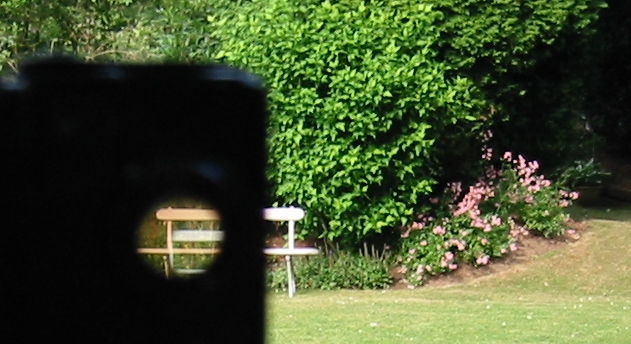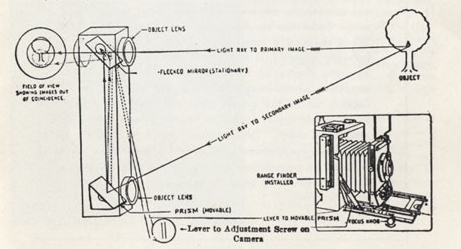

How the Kalart
Lens Coupled Range Finder works.
The American Kalart Synchronised Range Finder is coupled directly to the camera track, the most stable part of the camera.
This technique enables that turning the
focusing knob not only moves the lens forward and back but also operates the mechanism of the Range Finder, thus automatically synchronising it with the lens.
No other motions are required than those
normally used in operating the camera.
Simply open the camera and bring the standard forward to the infinity stops.
Then look at the object to be photographed through the eyepiece of the range finder
and turn the focusing knob of the camera.
When the two separate images of the subject, which are visible in a bright luminous circle, are superimposed
the proper focus is attained.

Picture above. The garden seat is out of focus.
The illustration at bottom of this page gives a very clear idea of the working principle of the Kalart Lens Coupled Range Finder.
When sighting
through the Finderís eyepiece the eye sees two circular images, which are either separated or merged in exact coincidence.
When the two images are in coincidence the subject is exact focus on the
ground glass or focal plane of the camera.
If the images are separated, they are brought into coincidence by turning the focusing knob, which operates the camera track.
This motion is transmitted to
the movable prism of the finder by means of the coupling arms.
The movement of this prism is controlled and adjusted, as will be explained later, to synchronise with the lens, which may be one of a
variety of focal lengths.
This is an exclusive and distinguishing feature of the Kalart Range Finder, since it not only permits compensating for commercial tolerance permissible in any given lens
but
also allows for readjusting the Range Finder when interchanging lenses.
Another important feature of this range finder is the fact that with the shorter focal length of lenses it will automatically focus objects as
close as 3 ft. from the camera.
This makes it particularly desirable over ground-glass focusing especially when working in dim light or when the camera must be
handheld.

Adjusting the Kalart Rangefinder